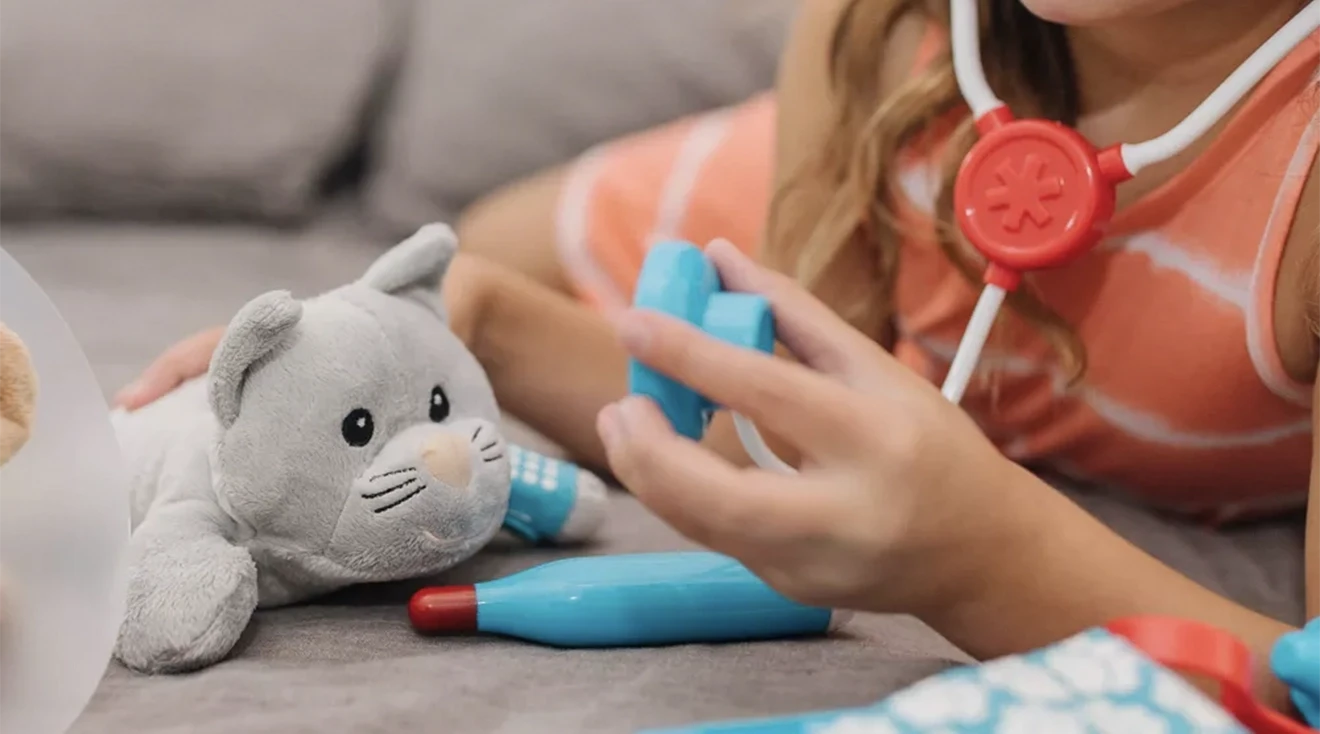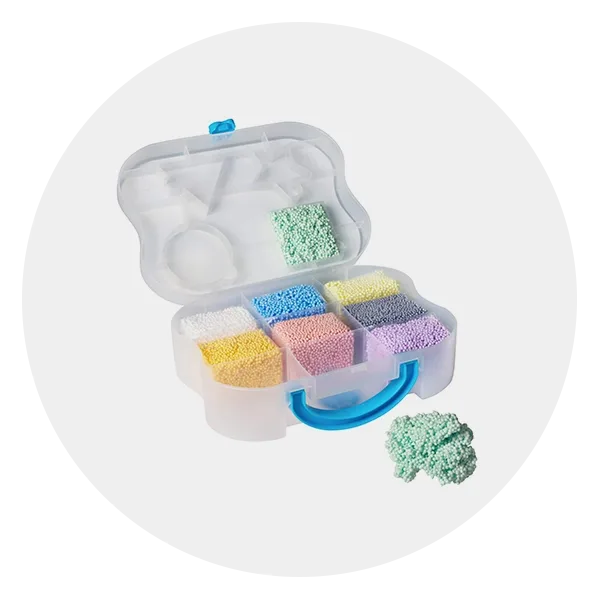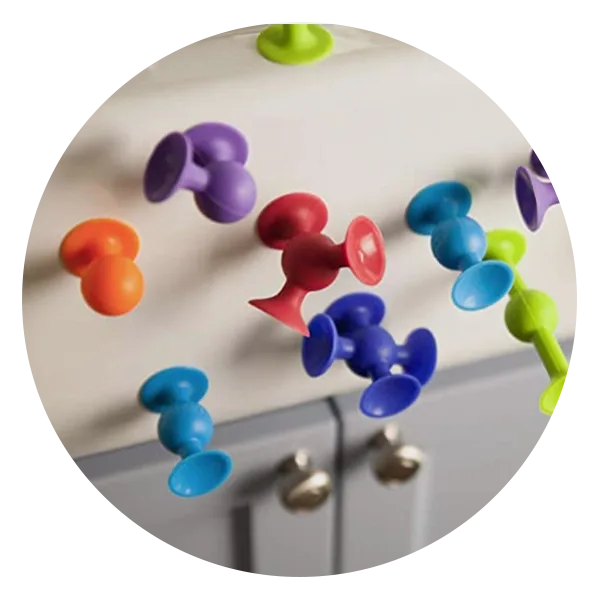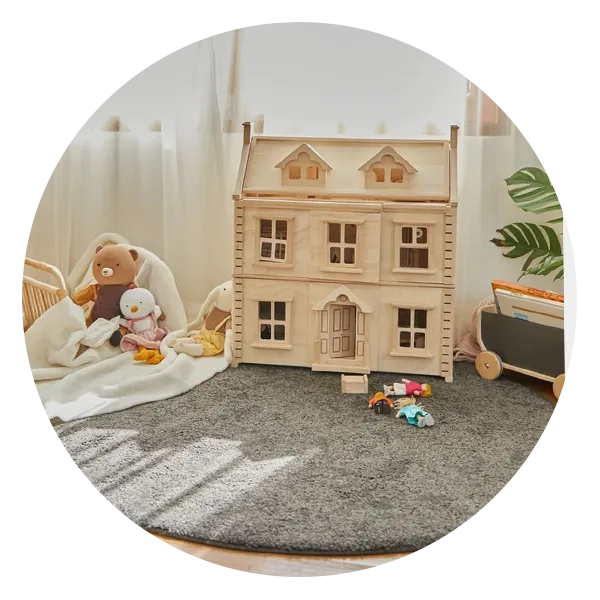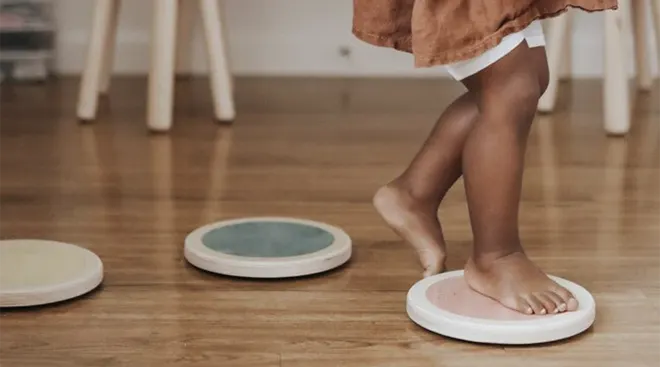20 Best Toys for Kids With Autism
Kids with Autism Spectrum Disorder (ASD) are just that—kids. And they want to play! So what are the best toys for autistic kids to encourage that exploration through play? “Their toys don’t have to be fancy or special ‘learning toys,’” says Jamie Winter, PhD, a psychologist at the Center for Autism and the Developing Brain at New York-Presbyterian Hospital in White Plains, New York. “They simply need to be toys that your child enjoys and that are developmentally appropriate.” In fact, the toys commonly found in playgroups, preschools and playrooms of neurotypical toddlers are the same kinds of toys that are beneficial to children with autism. “Puzzles, blocks, balls, cars and books are a great place to start for all kids,” says Winter. That said, the best toys for kids with autism do have some common threads. Below, some guidelines for selecting toys for autistic children, as well as some suggested toys to try out.
Your playroom can be stocked with the very best, but to make your collection of special needs toys truly impactful, get down on the ground and play with your child. “Playing with toys with others is an important way that children with ASD can learn,” says Winter. And don’t forget: Singing songs and playing with your child without toys is fun and important too! When it comes to the best toys for kids with autism, here are some of our top picks.
DIY Sock Puppets
- Peel-and-stick pieces are mess-free
- Promotes fine motor skills and self-expression
- Small parts require supervision around younger siblings
There are literally hundreds of play possibilities with these silly little sock puppets, making them standout toys for kids with autism. This 40-piece set comes with plenty of peel-and-stick felt shapes, adhesive-backed googly eyes and fuzzy embellishments to help children label body parts and start to piece together meanings in facial expression (a skill deficit that often goes hand-in-hand with an autism diagnosis). Having the freedom to create a character of their own imagination affords children with ASD agency to express their emotions and communicate what they’re feeling or thinking through a third party (aka the playful puppet). Plus, taking the accessories on and off helps develop the very muscle groups and fine motor skills needed for holding a pencil or fastening buttons.
Recommended age: 3+ years
Baby and Toddler Learning Toy
- Tactile bubbles promote sensory exploration
- Only one way to play
Some of the very best special needs toys are really just awesome toys, no matter who’s playing with them. Take the Dimpl from Fat Brain Toys. The concept is simple: five colorful silicone bubbles for toddlers to push, pop, poke and grab. Here, autistic and neurotypical toddlers alike learn cause and effect (i.e., “push this and it makes a noise”), engage their fine motor skills and explore sensory stimulation. All kinds of wins!
Recommended age: 10+ months
Train Set Toy
- More than one way to play
- Promotes imaginative play
- Track assembly might require adult supervision
Many children with autism adore trains: They lend well to categorizing, and train schedules make the concept of time less abstract. But complicated tracks can cause more frustration than fun. To up the enjoyment, take your play beyond simply chugga-chugging around the tracks. “Talk to the train, tell stories about the train, build imaginary scenes with the train,” says Rondalyn Varney Whitney, PhD, OTR/L, associate professor of occupational therapy at the West Virginia University School of Medicine. “Use the trains as a stepping stone for more play.” The narrative-building around the train and its passengers can jumpstart greater open-ended storytelling—about where folks may be headed, what adventures the animals are off to on the sidelines and more.
Recommended age: 18+ months
Tactile Building Blocks
- No wrong way to play
- Tactile blocks are easy to connect
- Promotes color and shape recognition
- 112 pieces
Virtually any kind of building blocks are great toys for autistic children because there are no right or wrong ways to engage—the play possibilities are endless! Plus, blocks are ideal for honing kids’ motor skills. What makes these stick-together/pull-apart blocks especially good toys for children with special needs is the bristly texture that adds some tactile stimuli.
Recommended age: 2+ years
Kids Playfoam
- Provides sensory stimulation
- Convenient carrying case is travel-friendly
- Less moldable than PlayDoh
- Colors can’t be separated once combined
Move over, PlayDoh! Kids with autism often take a special liking to this (nontoxic) molding foam that can be squished, sculpted and rolled into virtually anything, allowing children oodles of tactile stimulation. Playfoam is among the best special needs sensory toys, but it also provides a great fine-motor and creativity boost too. Other major pluses: It’s not sticky, it’s easy to clean up and it never dries out. (We love the carrying case too, so you can always have it with you.)
Recommended age: 3+ years
Pogo Jumper
- Promotes active play
- Not for younger children
A lot of children with autism have an over- or under-sensitive vestibular system, which is part of the sensory system involving balance and coordinating movement. “It’s not uncommon for children with autism to either seek movement, like bouncing or rocking—or avoid it—when they’re looking to regulate how they feel,” says Whitney. If you’ve got a seeker, consider adding kid-friendly pogo sticks to your arsenal of toys for autistic kids. This one has the added cause-and-effect bonus of creating a funny squeaking noise each time the child lands.
Recommended age: 5+ years
Edible Bubbles
- Four crowd-pleasing flavors for variety
- Works in bubble guns and machines
- Also safe for dogs
- Kids with autism can be sensitive to certain smells
“Scented bubbles offer a lot of different sensory stimuli—there’s watching, blowing, smelling, clapping or poking them to pop,” notes Whitney. These fun edible bubbles come in four great flavors that engage the sense of smell and taste—the Carnival Cotton Candy, Milk Chocolate Chip, Juicy Watermelon Splash and Glazed Cinnamon Roll bubble solutions are all made from food- and pharmaceutical-grade ingredients.
Recommended age: 3+ years
Play Kitchen for Kids
- Encourages language and identification skills
- Promotes social skill development through role-playing
- Requires a space commitment
- High price point
Pretend cooking, serving and turn-taking is fun for all kids. And since playing in this pint-size kitchen mimics everyday life and everyday social interactions, it’s helpful practice for children with special needs. “Here, a child has a safe way to practice social skills and pro-social behavior, where the idea of failure isn’t as overwhelming,” says Whitney. Plus, toys like a play kitchen encourage language and identification skills too.
Recommended age: 3+ years
Weighted Stuffed Animal
- Two modes of sensory input
- Lamb also available
- Higher price point than standard stuffies
A weighted stuffed animal is one of the best toys for autistic kids because their just-right heft provides sensory input that works to relax and focus the child’s body and mind. Your kiddo can stroke the puppy for additional tactile input that further decreases stress. And at 3.6 pounds, this pup might just be the perfect companion for your little one.
Recommended age: 3+ years
Sensory Pouches
- Offers a variety of tactile sensations
- Includes activity guide for various play scenarios
- Some reviewers find durability disappointing
Unlike slick, hard plastic toys, this bag of textures is jam-packed with sensory stimuli that are perfect toys for autistic toddlers. There are 20 different pillows and patches featuring tactile differences, like scratchy, silky and soft textures. An activity guide is included to help parents brainstorm different play scenarios.
Recommended age: 3+ years
Toy Bolts and Nuts
- Activity guide provides inspiration for play
- Promotes color and shape recognition
- Carrying case is convenient for travel
- Shapes must be matched to screw together
Toy bolts, nuts and screws make for wonderful playthings for autistic kids—after all, they’re pretty much the original fidget toy. Plus, there are the added bonuses of fine-motor tuning and open-ended play. This bright set includes 24 jumbo-sized pieces that twist together with ease, minimizing frustration. It comes with a drawstring tote bag too, to encourage your child to clean up once they’re done playing. Positive reinforcement awaits!
Recommended age: 18+ months
Construction Blocks Set
- Teaches basic physics, fine and gross motor skills
- Clean up can be tedious
Here, your kiddo can build an impressive block tower with 22 soft foam blocks, and then send their creation flying into the air—over 6 feet up! The silicone launch pad is equipped with an easy-to-use stomp lever that children can step on and witness cause-and-effect in action. Fine and gross motor skill sharpening? Check. Creative thinking encouraged? Yes. Fun toys for kids with autism and their siblings? You bet!
Recommended age: 3+ years
Play Tent for Kids
- Waterproof floor is ideal for outdoor use
- Folds flat for easy storage
- Tent and tube can be used separately for double the fun
- High price point
Some kids with autism (as well as neurotypical kids) can become overstimulated by their environment and crave a secret hide-out, away from noise and chaos. This hide-me tent and connecting tunnel does just that, while also building muscle and motor skills. It provides a fun environment that can be used both indoors and out—your kiddo will love having their own adventures in here!
Recommended age: 2+ years
Play Veterinary Set
- Encourages social and emotional skill-building
- Most pieces can be repurposed as toy doctor kit
- 24 pieces
Does your little one love animals? Let them practice their social-emotional skills with this veterinary playset, complete with a doggie and kitty that need a little TLC to get back on all four paws. Beyond social and emotional skill-building, these sweet animals—in all of their soft tactile glory—may just morph into comfort companions for your child too. The set comes with 24 pieces, including a stethoscope, medicine bottles, thermometer and more.
Recommended age: 3+ years
Fidget Noodles
- Promotes bilateral coordination
- No wrong way to play
- No connector pieces
Stretch ’em, pop ’em, twirl ’em—no matter how your child plays with these multi-colored noodles, they’ll get the one-two punch of auditory and tactile stimulation in one fabulous toy for autistic kids. These differently textured noodle toys can be bent, smooshed or stretched out to more than five feet long! And all that finger movement boosts motor skills too.
Recommended age: 3+ years
Chew Necklace
- Made of medical grade materials
- Free of lead, phthalates, PVC, BPA or latex
- Not indestructible; replacements may be needed
Chewing can be a very effective way for kids with autism to calm themselves and self-regulate. To keep your child’s fingernails, sleeves and fingers bite-free, turn to chewelry (chew + jewelry = chewelry), a great on-the-go way to get oral sensory input. We love that they come in three color-coded toughness levels—from soft/standard to XXT/super firm—to keep up with your child. The brand’s POV states that if your little one is regularly chomping down on things like “LEGO pieces, hard plastic toys or wooden items” or has chewed through the XT/medium firm pendants, then they’d probably enjoy the XXT chewie.
Recommended age: 5+ years
Visually Stimulating Bubble Toy
- Relaxes both children and adults
- Multipack makes calming effects available all over the house
- Some reviewers report low durability
Visual sensory-seekers love toys that offer the calming blub, blub, blub of colorful bubbles moving up and down. This type of visually stimulating toy offers tons of calming entertainment for everyone. (There’s a reason these things are often spotted on the desks of stressed out executives!) When the bubbles stop after two minutes, just flip the toy over and start again. Bonus: If you go with a multipack, you can stash a bubbler in your bathroom, the car, their backpack, a grandparent or family member’s house, etc. so you always have one on hand.
Recommended ages: 4+ years
Suction-Cup Toys
- No wrong way to play
- BPA- and latex-free
- Dishwasher safe
- 50-piece set means a lengthy clean up
Many top-notch toys for autistic kids simply hand control over to the child. “When children have volition over the toys—like when they have the ability to turn it into multiple things—great fun and learning happens,” says Whitney. Squigz, for instance, are a set of 50 suction-y shapes that stick together (and to various surfaces) to create, well, anything. Plus, the push-and-pull is great for fine-motor building.
Recommended age: 3+ years
Toy Wooden Dollhouse
- Chemical-free rubberwood and formaldehyde-free glue
- Encourages social role playing and imaginative play
- Timeless toy can be used for years to come
- Sizeable investment
Start with this plain wooden house as a blank canvas, and let your child dream up the play scenario that makes the most sense to them. Here, kids can engage in imaginary play and, at the same time, work on developing social and emotional skills that’ll serve them well outside of the playroom too. It’s also a great way to encourage shared play experiences for your child and their siblings.
Recommended age: 3+ years
Dress-Up Play Set
- Encourages creativity and pattern recognition
- Lidded wooden box is ideal for travel
- 45 pieces
Reading and understanding other people’s facial expressions can be tough for those with autism, so it’s smart to get toys for autistic children that provide fun opportunities to work on this skill at home. Enter: This too-cute bear family that comes with 45 interchangeable pieces, including different facial expressions like surprised and sad. It’s also an awesome toy for building hand-eye coordination and dexterity.
Recommended age: 3+ years
While selecting gifts for kids with autism can be daunting, we’ve done the research for you by scouring all of the best gift lists and cross-listing with reviews as well as experts in the field of autism and childhood development. Durability, cost, portability, ease of clean up and of course, fun factor all figure into our top picks. But we also consider safety so you can ensure that the most beloved gifts are also innocuous.
We also read user reviews to see how these toys held up for real families, and only considered products with at least an average four-star rating. And since many of us are also parents, our writers and editors rely on experience with their own families.
Interested in learning more about our editorial process? Read about how our team develops and reviews all articles here.
Before you start filling your virtual shopping cart with special needs toys, know this: First and foremost, toys for kids with autism need to be fun! Here’s what else to keep in mind:
- Embrace high-interest toys. Children with autism can become very interested in one thing, like trains or dinosaurs. “Sometimes parents try to stop the intensity of their child’s interest, thinking it’s a habit that needs to be broken,” says Whitney “But interest is interest, and you should go with it. Simply think about ways to use that interest to expand play and learning.”
- Avoid overstimulating toys. “Many children with ASD become overstimulated by electronic toys with a lot of lights, sounds and moving parts,” says Winter. Playing with these can not only lead to meltdowns, but children often also focus exclusively on the toy and don’t pay any attention to other children or adults around them.
- Think beyond age-grading. Toy manufacturers age-grade their toys so parents can understand what’s age-appropriate—both from a safety and developmental standpoint. But when it comes to toys for autistic kids, as long as they don’t pose a safety hazard for your child, so what if the toy packaging reads ages 5+? Only you know what playthings are truly appropriate for your child’s developmental stage. “Some children with autism have intellectual disabilities—and some don’t,” says Whitney. “In fact, many have at or above intellectual ability.” Bottom line: Trust your gut and pick toys that meet your child where they are developmentally, keeping safety top of mind.
- Choose no-wrong-way-to-play toys. Toys that can be played with in a lot of different ways are among the best toys for kids with autism. “They’re especially good for children who have inconsistencies in their development,” notes Whitney.
- Look for just-right sensory stimulation. Children with autism typically crave a particular sensory input. Some gravitate toward the tactile (perhaps touching certain textures is calming), while others prefer to stimulate their proprioceptive system, which is basically joints and muscles (spinning or jumping might regulate their mood). And many have various sensory needs. “Look for toys that have lots of sensory pieces that your child will enjoy,” says Whitney.
- Limit available toys. “It’s often problematic to have many toys out and available at the same time,” notes Winter. “Containers with lids, cabinets or shelving to put toys away will help you teach your child to clean up and to limit distractions.”
Please note: The Bump and the materials and information it contains are not intended to, and do not constitute, medical or other health advice or diagnosis and should not be used as such. You should always consult with a qualified physician or health professional about your specific circumstances.
Plus, more from The Bump:
Jamie Winter, PhD, is a psychologist at the Center for Autism and the Developing Brain at New York-Presbyterian Hospital in White Plains, New York. She provides individual therapy for children, as well as parent coaching.
Rondalyn Varney Whitney, PhD, OTR/L, is an associate professor of occupational therapy at the West Virginia University School of Medicine. Her work focuses on ideas like the co-regulation of a child and adverse childhood experiences.
Navigate forward to interact with the calendar and select a date. Press the question mark key to get the keyboard shortcuts for changing dates.
































